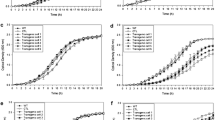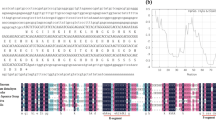Abstract
The role of late embryogenesis abundant (LEA) proteins in stress tolerance was examined by using a yeast expression system. LEA protein tolerance to the abotic stresses in plants involved in salt, drought and freezing stresses and additional tolerance to heat, Na-HCO3 (salt-alkali) and ultraviolet radiation was also investigated. The transgenic yeast harboring the Tamarix LEA gene (DQ663481) was generated under the control of inducible GAL promoter (pYES2 vector), yeast cells transformed with pYES2 empty vector were also generated as a control. Stress tolerance tests showed that LEA yeast transformants exhibited a higher survival rates than the control transformants under high temperature, NaHCO3, ultraviolet radiation, salt (NaCl), drought and freezing, indicating that the LEA gene is tolerant to these abiotic stresses. These results suggest that the LEA gene is resistant to a wider repertoire of stresses and may play a common role in plant acclimation to the examined stress conditions.
Similar content being viewed by others
References
Babu RC, Zhang JX, Blum A, Ho THD, Wu R, Nguyen HT. 2004. HVA1, a LEA gene from barley confers dehydration tolerance in transgenic rice (Oryza sativa L.) via cell membrane protection. Plant Sci, 166(4): 855–862.
Chourey K, Ramani S, Apte SK. 2003. Accumulation of LEA proteins in salt (NaCl) stressed young seedlings of rice (Oryza sativa L.) cultivar Bura Rata and their degradation during recovery from salinity stress. J Plant Physiol, 160(10): 1165–1174.
Danyluk J, Perron A, Houde M, Limin AE, Fowler DB, Benhamou N, Sarhan F. 1998. Accumulation of an acidic dehydrin in the vicinity of the plasma membrane during cold acclimation of wheat. Plant Cell, 10(4): 623–638.
Galau GA, Wang HY, Hughes DW. 1993. Cotton Lea5 and Lea14 encode atypical late embryogenesis-abundant proteins. Plant Physiol, 101(2): 695–696.
Grelet J, Benamar A, Teyssier E, Avelange-Macherel MH, Grunwald D, Macherel D. 2005. Identification in pea seed mitochondria of a late-embryogenesis abundant protein able to protect enzymes from drying. Plant Physiol, 137(1): 157–167.
Goyal K, Walton LJ, Tunnacliffe A. 2005a. LEA proteins prevent protein aggregation due to water stress. Biochem J, 388, 151–157.
Goyal K, Walton LJ, Browne JA, Burnell AM, Tunnacliffe A. 2005b. Molecular anhydrobiology: identifying molecules implicated in invertebrate Anhydrobiosis. Integr Comp Biol, 45(5): 702–709.
Han Y, Wilson DB, Lei XG. 1999. Expression of an aspergillus niger phytase gene (phyA) in Saccharomyces cerevisiae. Appl Environ Microbial, 65(5): 1915–1918.
Hasegawa PM, Bressan RA, Zhu JK, Bohnert HJ. 2000. Plant cellular and molecular responses to high salinity. Annu Rev Plant Physiol Plant Mol Biol, 51: 46–499.
Jeong MJ, Park SC, Kwon HB, Byun MO. 2000. Isolation and characterization of the gene encoding Glyceraldehyde-3-Phosphate Dehydrogenase. Biochem Biophys Res Commun, 278(1): 192–196.
Kim HS, Lee JH, Kim JJ, Kim CH, Jun SS, Hong YN. 2005. Molecular and functional characterization of CaLEA6, the gene for a hydrophobic LEA protein from Capsicum annuum. Gene, 344: 115–123.
Liang CY, Xi Y, Shu J, Li J, Yang JL, Che KP, Jin DM, Liu XL, Weng ML, He YK, Wang B. 2004. Construction of a BAC library of Physcomitrella patens and isolation of a LEA gene. Plant Sci, 167(3): 491–498.
Mahalakshmi S, Christopher GS, Reddy TP, Rao KV, Reddy VD. 2006. Isolation of a cDNA clone (PcSrp) encoding serine-rich-protein from Porteresia coarctata T. and its expression in yeast and finger millet (Eleusine coracana L.) affording salt tolerance. Planta, 224(2): 347–359.
Manfre AJ, Lanni LM, Marcotte Jr, WR. 2006. The Arabidopsis group 1 LATE EMBRYOGENESIS ABUNDANT protein ATEM6 is required for normal seed development. Plant Physiol, 140(1): 140–149.
Moons A, De KA, Van MM. 1997. A group 3 LEA cDNA of rice, responsive to abscisic acid, but not to jasmonic acid, shows variety-specific differences in salt stress response. Gene, 191: 197–204.
Posas F, Chambers JR, Heyman JA, Hoeffler JP, de Nadal E Arino J. 2000. The transcriptional response of yeast to saline stress. J Biol Chem, 275(23): 17249–17255.
Rausell A, Kanhonou R, Yenush L, Serrano R, Ros R. 2003. The translation initiation factor eIF1A is an important determinant in the tolerance to NaCl stress in yeast and plants. Plant J, 34(3): 257–267.
Raynal M, Gaubier P, Grellet F, Delseny M. 1990. Nucleotide sequence of a radish cDNA clone coding for a late embryogenesis abundant (LEA) protein. Nucleic Acids Res, 18(20): 6132.
Serrano R, Montesinos C. 2003. Molecular Bases of Desiccation Tolerance in plant cells and potential applications in food dehydration. Food Sci Technol Int, 9(3): 157–161.
Serrano R, Rodriguez-Navarro A. 2001. Ion homeostasis during salt stress in plants. Curr Opin Cell Biol, 13: 399–404.
Shao HB, Liang ZS, Shao MA. 2005. LEA proteins in higher plants: Structure, function, gene expression and regulation. Colloids Surf B Biointerfaces, 45(3–4): 131–135.
Shih MD, Lin SC, Hsieh JS, Tsou CH, Chow TY, Lin TP, Hsing YI. 2004. Gene cloning and characterization of a soybean (Glycine max L.) LEA protein GmPM16. Plant Mol Bio, 56: 689–703.
Shimamura C, Ohno R, Nakamura C, Takumi S. 2006. Improvement of freezing tolerance in tobacco plants expressing a cold-responsive and chloroplast-targeting protein WCOR15 of wheat. J Plant Physiol, 163: 213–219.
Soulages JL, Kim K, Walters C, Cushman JC. 2002. Temperature-Induced extended Helix/Random coil transitions in a group 1 late embryogenesis-abundant protein from Soybean. Plant Physiol, 128(3): 822–832.
Wang YJ, Yu JN, Chen T, Zhang Z, Hao Y, Zhang J, Chen S. 2005. Functional analysis of a putative Ca2+ channel gene TaTPC1 from wheat. J Exp Bot, 56(422): 3051–3060.
Zhang XX, Takano T, Liu SK. 2006. Identification of a mitochondrial ATP synthase small subunit gene (RMtATP6) expressed in response to salts and osmotic stresses in rice (Oryza sativa L.). J Exp Bot, 57(1): 193–200.
Author information
Authors and Affiliations
Corresponding author
Additional information
Foundation project: This research was supported by National Key Program on Basic Research and Development of China (G1999016003).
Rights and permissions
About this article
Cite this article
Wang, Bf., Wang, Yc., Zhang, Dw. et al. Verification of the resistance of a LEA gene from Tamarix expression in Saccharomyces cerevisiae to abiotic stresses. Journal of Forestry Research 19, 58–62 (2008). https://doi.org/10.1007/s11676-008-0010-y
Received:
Accepted:
Published:
Issue Date:
DOI: https://doi.org/10.1007/s11676-008-0010-y




